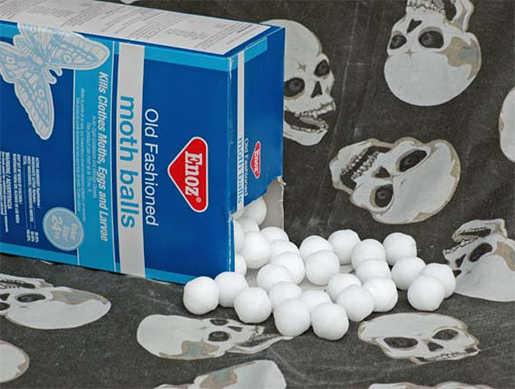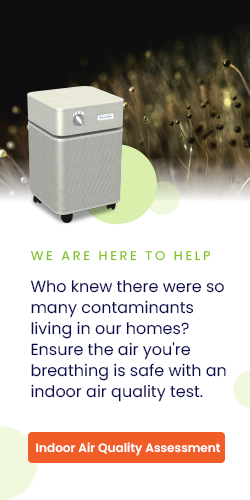Mothballs have long been a household staple, used to protect clothing from moths and other fiber-hungry pests. However, what many people don’t realize is that these seemingly harmless white spheres are actually classified as pesticides. Containing either naphthalene or dichlorobenzene, mothballs release toxic fumes that can significantly harm your health—and the health of your loved ones.
In this article, we’ll explore why mothballs are toxic, the health risks they pose, and what you can do to protect your indoor air quality.
What Are Mothballs, Really?
Mothballs come in several forms—balls, flakes, cakes, blocks, and even enclosed packets—and are used to repel pests like moths and rodents from clothing, rugs, and storage spaces. While their strong, pungent smell is familiar, the danger lies in what you can’t see: the invisible, chemical-laden vapors that they emit.
The two most common active ingredients in mothballs are:
- Naphthalene: A hydrocarbon derived from coal tar or crude oil, also used in plastics, dyes, fuels, and solvents.
- Dichlorobenzene: A chlorinated volatile organic compound (VOC) used in deodorizers, air fresheners, and animal repellents.
Both chemicals vaporize at room temperature, which means you’re continuously inhaling them whenever mothballs are present—even if they’re in sealed containers.
Why Are Mothballs Toxic?
1. Toxic Fumes You Can’t Escape
Mothballs work because their vapors are lethal to insects. Unfortunately, those same vapors are harmful to humans and pets. Breathing in these chemicals—even in small doses over time—can lead to:
- Headaches
- Dizziness
- Nausea
- Eye and respiratory irritation
- Coughing
Children and pets are especially vulnerable, as their developing bodies and proximity to the floor (where vapors accumulate) increase their exposure risk.
2. Severe Health Conditions
Long-term exposure to naphthalene has been linked to hemolytic anemia, a dangerous condition where red blood cells are destroyed faster than they can be replaced. This is especially dangerous for individuals with G6PD deficiency. Other potential effects include:
- Liver and kidney damage
- Skin irritation from contact
- Accidental poisoning (particularly in children and pets)
3. Cancer Risk
The U.S. Department of Health and Human Services lists naphthalene as a possible human carcinogen. Prolonged exposure may increase the risk of cancer, particularly in the respiratory tract. Dichlorobenzene also raises concerns due to its similar chemical structure and toxic profile.
Improper Use of Mothballs: A Common Hazard
Many people store mothballs in areas like closets, trunks, attics, or basements, unaware that these closed spaces allow chemical vapors to concentrate to dangerous levels. Others scatter them outdoors to repel rodents, unknowingly contaminating nearby soil and water.
Even when used “as directed,” mothballs are dangerous:
- Vapors can escape from sealed packaging
- Fumes linger even after removal
- They present a fire hazard—especially naphthalene, which is highly flammable
A Safer Alternative: Cedar and Proper Storage
If you’re looking for a pest deterrent that doesn’t come with the same toxic burden, cedar chips, blocks, or oils offer a natural alternative. Be sure to:
- Store off-season clothing in airtight containers
- Avoid putting mothballs in open areas or near living spaces
- Always wash items that have been exposed to mothballs before wearing
How to Test for Naphthalene or Dichlorobenzene
Because mothballs release vapor continuously, their chemical footprint lingers long after the mothballs are removed. If you suspect exposure in your home, testing is the only reliable way to confirm the presence of harmful VOCs like naphthalene or dichlorobenzene.
IndoorDoctor’s On Demand Chemical Testing makes it easy. With our IndoorDoctor On-Demand Chemical Mothball Testing, you can collect a sample in your home and send it to our lab for expert analysis. Our equipment uses photoionization detection (PID) technology to detect total VOCs down to parts per billion (ppb). We can also identify specific chemicals—including mothball-related compounds—and their likely sources.
Whether you’re worried about long-term exposure or a recent incident, we’ll provide a personalized action plan to help clean your air and protect your health.
Protect Your Indoor Air—Protect Your Health
With Americans spending 90% of their time indoors, indoor air quality is more important than ever. Mothballs may seem like a simple solution for pest control, but their chemical impact is anything but small.
The EPA estimates that 6 out of 10 homes have air quality issues serious enough to make them “sick buildings.” If you’re experiencing symptoms like headaches, fatigue, or eye irritation, it could be due to toxic indoor pollutants like mothball vapors.
Let IndoorDoctor Help
We’re committed to helping you breathe easier. Contact us today at 800-466-1522 or fill out our online form to schedule a consultation.
Don’t let hidden chemical dangers take root in your home. Take action today for a healthier tomorrow.
Why Are Mothballs Harmful? Are Mothballs Toxic?
Mothballs are essentially small balls of chemicals and deodorant, which we typically use to drive away moths or other pests from natural fibers, especially wool. Although we refer to them as mothballs, they are available in other forms, like crystals, flakes, cakes, and blocks. You can also find them in cans, packets, and cases. If you’ve ever come near a mothball, you know the scent. They have a distinct pungent smell, sometimes described as acrid or like camphor.
Toxic Odor
As you take in this scent, you might not realize that you’re also breathing in toxic chemicals. Mothballs are effective because their active ingredients, either naphthalene or dichlorobenzene, vaporize at room temperature. The chemicals you’re breathing in are the same that kill the pests you want to get rid of.
Naphthalene is a hydrocarbon that we extract from crude oil or coal tar. We also use it to make plastic, resin, dye, and fuel. Dichlorobenzene, meanwhile, is a chlorinated volatile organic compound (VOC), that we use as a deodorizer in toilets and diaper pails, or as an animal repellant against mice, rats, snakes, bats, squirrels, and more. These chemicals may sometimes be hard to spot, as their names can appear differently on products. Dichlorobenzene is also known as para-dichlorobenzene, and can be referred to as p-dichlorobenzene, pDCB, or PDB.
Exposure to these chemicals can be harmful whether you breathe in the vapors or touch them directly with the skin. They are also harmful if ingested, which typically happens accidentally. For example, if you fail to wash your hands after touching a mothball and then handle food. Children or pets may even mistake mothballs for food, which can have serious health effects.
The Dangers of Naphthalene and Dichlorobenzene
Naphthalene and dichlorobenzene can have many negative impacts on your health, including:
- Nausea
- Headaches
- Coughing
- Eye irritation
- Nose irritation
In particular, naphthalene can cause more severe conditions, like hemolytic anemia. This is a disorder in which you have a lower-than-normal amount of red blood cells because the body is destroying them faster than it can make them. Extended exposure to mothballs can even cause liver and kidney damage.
Health Risk
There is also a greater health risk for children. Since mothballs looks like candy, children sometimes accidentally eat them. If the child isn’t under constant supervision, you may not even know that the child consumed a mothball. About 4,000 children are exposed to mothballs each year, with 600 of those cases requiring medication attention. A key indicator that your child has consumed a mothball and needs medical attention is jaundice, which you can spot by looking for yellow skin. Plus, even if you don’t consume them, the fumes from mothballs are heavier than air. This means they sink to the floor and accumulate, putting both children and pets at risk.
Cancer Causing
On top of these health effects, we consider naphthalene a possible carcinogen, which means that it may cause cancer in humans. For example, asbestos is a known carcinogen, and exposure to it is strongly linked to lung cancer. While we consider naphthalene as a possible carcinogen, it’s important to know that it may have more serious health implications.
Storage Problems
Per package directions, mothballs should only ever be in tightly closed containers, although even these containers may release vapors. Mothballs are particularly dangerous because they are often used incorrectly. They shouldn’t be placed in closets, storage chests, trunks, garment bags, basements, or attics. In these closed-off areas, gasses from the mothballs can accumulate at high levels, making it even more dangerous for you to come into contact with. People sometimes put mothballs outside to repel rodents or other unwanted pests, but the mothballs can contaminate the water and soil.
Additionally, mothballs are a fire hazard. Naphthalene is highly flammable, which is why dichlorobenzene in many more modern mothballs has replaced it. However, both chemicals have the same NFPA 704 code for flammability. The vapor that comes off of mothballs and kills pests is flammable, making them a serious fire hazard. This is something to consider before placing mothballs in your home.
If you truly need something to protect your clothing from moths and other unwanted pests, try using cedar chips instead. Be sure to wash any clothing in contact with mothballs before wearing it.
How to Test for Naphthalene or Dichlorobenzene
Since mothballs release vapor, the chemicals remain even when you remove the mothballs themselves. Although they are safer when in cans, there is still a danger of the chemicals leaking out into the air. So how can you know for sure whether you have naphthalene or dichlorobenzene contaminating the air in your home? The best way to find out is by testing the chemical levels.
IndoorDoctor can detect the total chemical levels in your space with photoionizing detectors (PID) down to parts per billion. Our advanced chemical testing can even identify the specific chemicals and their sources. We can service you regardless of where you live in the U.S. by using our remote testing capability. You’ll take a sample of your indoor air, and we take care of the rest in our laboratory. Once we determine what chemicals are in your home, we can recommend an action plan to clean your air.
Keep Your Space Healthy
Since most people spend 90% of their time indoors, it’s important to make sure that the air you’re breathing is safe for you and your loved ones. Air pollution from mothballs can cause mild effects, like headaches and eye irritation, as well as more severe effects, like anemia and potentially even cancer. The unfortunate reality is that many homes have air pollution, whether from mothballs or other contaminants. The EPA reports that 6 out of every 10 homes and buildings are sick, meaning that they have airborne pollutants that are hazardous to your health. If you’re concerned about your home’s air quality, fill out our contact form or call us today at 800-466-1522. We’re here to ensure that you can breathe easily, knowing that your air is safe.
References
- Environmental Protection Agency (EPA). “Mothballs.” https://www.epa.gov
- U.S. National Library of Medicine – TOXNET Database (via PubChem).
- Naphthalene: https://pubchem.ncbi.nlm.nih.gov/compound/naphthalene
- Dichlorobenzene: https://pubchem.ncbi.nlm.nih.gov/compound/1_4-dichlorobenzene
- Agency for Toxic Substances and Disease Registry (ATSDR). “Toxicological Profile for Naphthalene.” https://www.atsdr.cdc.gov
- California Office of Environmental Health Hazard Assessment (OEHHA). “Proposition 65 List.” https://oehha.ca.gov/proposition-65
- National Pesticide Information Center (NPIC). “Mothballs – Naphthalene and Dichlorobenzene.” http://npic.orst.edu/factsheets/mothballs.html




